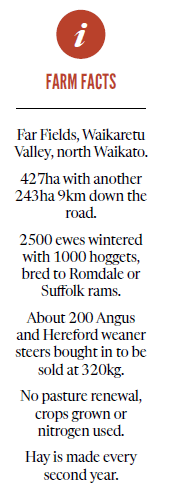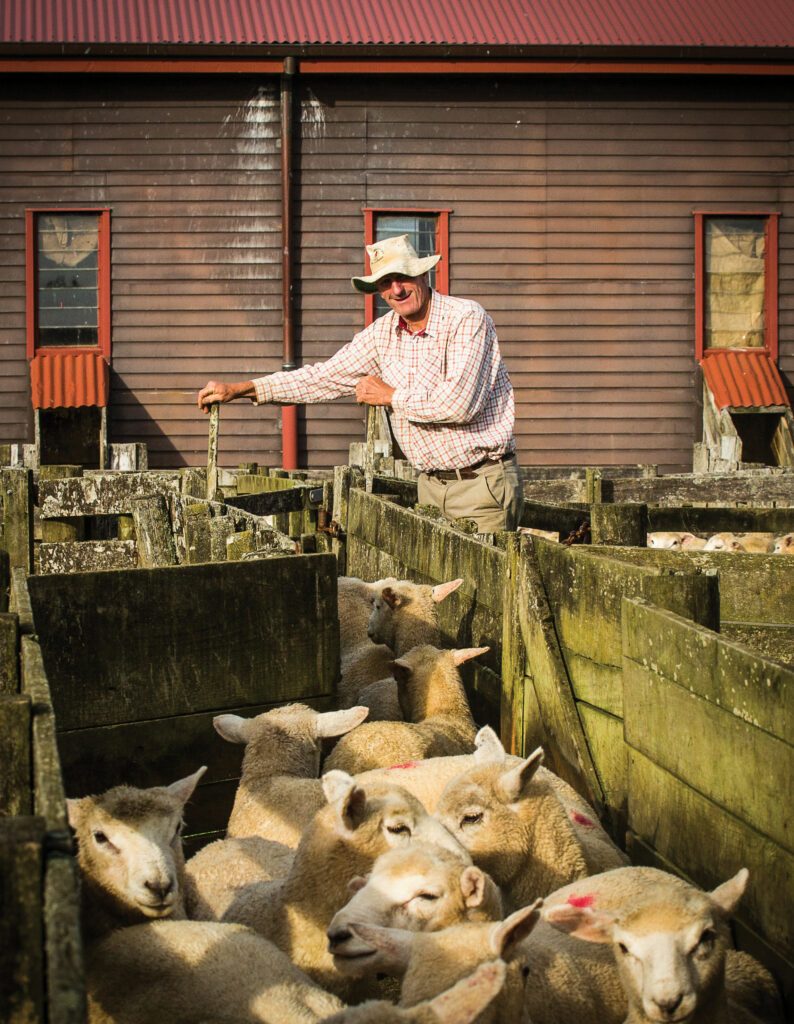Poplars and willows give umbrella-like shelter for the lambs on Tom Mandeno’s north Waikato farm, writes Glenys Christian.
Thanks to the poplars and willows planted on his north Waikato farm, Tom Mandeno is able to finish all his lambs on his steeper country rather than using the flats.
“Poplars do a great job through the hot, dry summers,” he says.
“Lambs do so much better sitting under an umbrella.”
He first became interested in the species back in the 1980s when the Waikato Valley Authority had a subsidised pole planting programme with the aim of stabilising erosion-prone hills and gullies. He was a Raglan County councillor at the time and needed no convincing that there would be many associated benefits such as providing shade and shelter for livestock as well as being able to farm less intensively.
So, he became a foundation trustee of the Poplar and Willow Research Trust when it was formed in 2011, with the aim of speeding the development of new, improved species. Since then, trials have been carried out on his farm, broadening and improving the range from the three species which had been commonly used in the past.
“You want a poplar with most of the growth below the ground and not much above,” he says.
The worth of the research he believes has already been proven with a greater resistance to salt carried off the Tasman Sea by onshore winds. And in a serious storm, such as Dovi earlier this year, only a few were lost.
In 1973 he bought the 315ha farm, Far Fields, in the Waikaretu Valley, then met and married Anna, who is a nurse. They moved on to the farm in 1978, a couple of years after building a dam to improve the water supply. More recently a solar-powered pump has been added to make the most of grazing made available by developing more of the hill country.
Gradually stock numbers were expanded to 4000 ewes but just a few cattle were run. In 1980 a smaller 240ha farm was bought 9km along the road, giving them more scale.
“We had a lot of debt and wool was what got us through the difficult times in the 1980s,” he says.

Gradually they moved cattle numbers up with Tom’s eye for stock refined by having bought for his Dalgety’s clients, so he could eventually buy those of a similar quality for their farm. About 2500 ewes are now wintered along with 1000 ewe hoggets, with all replacements bred on farm. They’ve tried different ram breeds over the years, now using a Romdale on most of the flock with lambing starting in August. That’s a month earlier than the one third of their ewes going to a terminal Suffolk ram. Lambing averages about 130%.
Buying rams from local farms where selection for facial eczema (FE) tolerance has been carried out means good flock survivability exists. Tom well remembers local farmers’ advice that rams bred in an area where they were exposed to facial eczema was a big step towards eliminating a disease which resulted in substantial losses. His ewes receive only a mineral drench as a result of their built-up immunity to FE and internal parasites.
The first draft of lambs go to the meat works in early December with Tom pleased with 630 of them reaching more than 19kg carcaseweight and an average price of $177 last year.
The sheep are shorn twice a year, using local shearers in early May then again in early December. Five-year-old ewes are sold at the Tuakau ewe fair along with any surplus two-tooths.
“It’s a simple system,” Tom says.
Their traditional Angus and Hereford cattle are all bought as weaner steers from the autumn fairs. The aim is to get them to a carcaseweight of about 320kg at from two and a half to three years of age.
The yearlings and young steers go on to the harder hills where they grow out and make a good job of cleaning up rough feed, then are driven to the home farm for finishing.
There’s no pasture renewal carried out with Tom dubious about the merits of new species.
“I have the old-fashioned idea that the pastures which are here and have survived for 50 years perform best,” he says.
“Nothing else has done as well.”
About 180 tonnes of Superplus is applied annually, with 120t going on to the home farm and 60t topdressed on to the smaller block.
“We don’t use any nitrogen,” he says.
“Our clover does that for free so that’s one environmental box we can tick.”
Soil tests are carried out every three or four years with the latest results from last year showing pH levels ranging between 5.7 and 6.2 and Olsen P from 15 to 33. Lime used to be applied from a local Waikaretu lime works but when that closed a switch was made to using dicalcic lime for a while.
While no crops are grown, hay is made every second year.
“It’s good for the weaners and helps them settle down.”
Feral deer, pigs and goats can be a problem in the four bush blocks and Canada geese make unwelcome visitors on the lake. Stock manager, Steve Bryant, has been on the farm for the past five years.
Increasingly Tom spent more time off-farm, with Anna running the properties in his absence. His first foray into local government was when he was elected to Raglan County Council back in 1983. Then in 1988 he gained a Nuffield Scholarship to visit the UK and Europe, studying the reorganisation of rural local government, particularly in Scotland.
Back home, he served on the Waikato Regional Council’s (WRC) West Coast Catchment committee for nine years.
“There were some pretty difficult times,” he says
“In the 1980s the pelt on a lamb was worth more than its meat value.”
The increase from about 50 cents/kg to today’s $8-9/kg is “amazing”. Federated Farmers’ meat and wool chairman of the time, Snow Petersen, called for a $30 lamb, which seemed unobtainable to many.
“A store lamb was worth $5, and you could get $5/kg for wool,” Tom says.
“So you were better to grow an extra kilo of wool rather than increase stock numbers.”
In 1990, deciding to run for a seat on the Wool Board he visited all the members of the electoral committee for both it and the Meat Board and was elected the following year. He became deputy chairman after being unseated during the rise of the Farmers for Positive Change lobby group in the 1990s.
At one stage the Wool Board had grower reserves of more than $400 million.
“But no one’s going to get back into market intervention and wool stockpile storage again.”
Lighting a spark
Coming out of school, Tom worked on his parents’ sheep and beef farm at Orere Point, southeast of Auckland for a year. Then he went to Ruakaka Station out of Gisborne to work as a shepherd before enrolling at Massey University to gain a diploma of sheep farming.
He wrote away and, sight unseen, was accepted for a shepherding job on Mount Possession Station in the Ashburton Gorge. He was issued a very important instruction by manager, Rob Chaffey – bring a good supply of manuka poles for mustering sticks on the high single slopes!
So he and his five dogs set off to travel south, with him spending an enjoyable 18 months on the 45,000 hectare high country run which carried 24,000 Merinos and 1200 Hereford cattle.
After his southern adventures and back in the north again, he threw himself into Young Farmers Club (YFC) activities, entering the very first Skellerup Young Farmer of the Year in 1969 as a 23-year-old hopeful. He made it through to be the youngest of the four national finalists with Gary Fraser the winner.
“That lit a bit of a spark,” he says.
So he applied to be the NZ YFC representative for the International Farm Youth Exchange programme for 1970, sponsored by the producer boards and shipping line P&O. Tom was selected and with the Australian young farmer travelled to the United States on the liner Canberra. He spent six months in host states South Dakota and Virginia then six weeks in Ontario, Canada, on different farms.
He then went to the United Kingdom where his mother had been born and where she had met his father when he was a Royal Air Force squadron leader during the Second World War. He spent a season as a courier/driver leading 14 minibus passengers on nine-week camping tours in Europe with Contiki Travel before returning home.
On the night of the Skellerup final Tom had the opportunity to talk with guest of honour, Sir Brian Talboys, who recommended he follow his path of getting a job at stock and station agents Dalgety. So with Tom’s father being a client and a vacancy to fill he became an agent and auctioneer at Tuakau, southwest of Auckland, for the next six years.
“That was when we had 70 million sheep and there were massive sheep sales there,” he says.
Producer board directorships
He remained on the wool board from 1991 until its disestablishment in 2003, and then became a farmer-elected director of Meat and Wool NZ and the NZ Meat Board until 2009.
Closer to home, he became a director of the C Alma Baker Trust in 1998, which runs nearby Limestone Downs, right on the west coast. Much research has been carried out in recent years on Wiltshire sheep, and with the addition of a dairy herd over 10 years ago, there’s been a focus on taking the surplus beef animals produced to an older age. The now NZ-based trust will celebrate its centenary in 2026.
Tom’s also been a Justice of the Peace for almost 30 years and has been involved with the Waikato-Hauraki-Coromandel Rural Support Trust as a facilitator for the last six.
“It brings people together and gets them off the farm,” he says.
“It can be a long, lonely battle for some of them.”
He remains very positive about sheep and beef prospects.
“It’s a great industry and a cornerstone of the economy,” he says.
“People want to eat our high-quality produce. Just look at how strong the market is in China.
He’s been involved with agricultural projects during the terms of six ministers of agriculture.
“If we ever needed a powerful ministerial voice to support a viable future for New Zealand agricultural exports, it is now,” he says.
“And we’ve got smart young people coming through. That gives me confidence for our future.”




